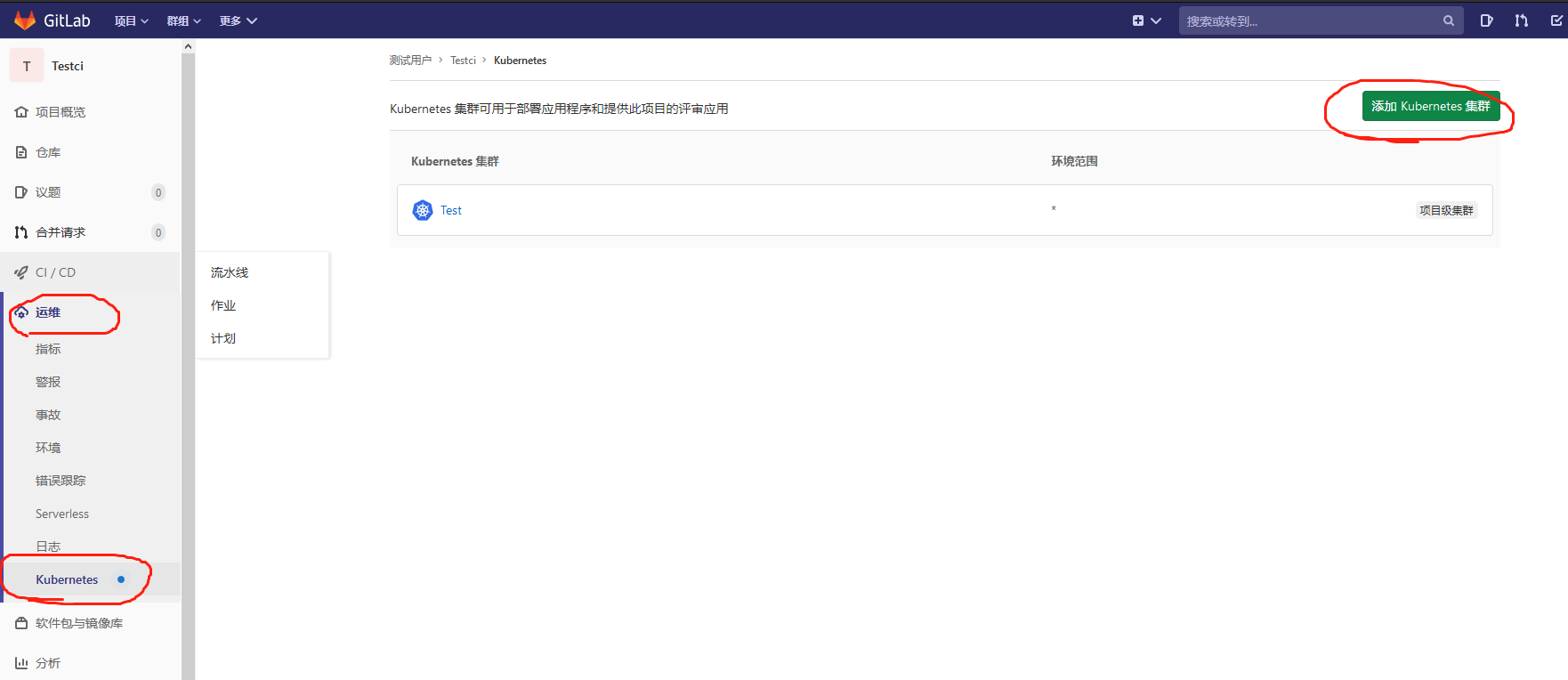Gitlab添加K8S集群
介绍如何在Gitlab项目中添加K8S集群,以便使用K8S集群部署gitlab-runner帮我们运行gitlab的CI/CD。
参考官方文档:https://docs.gitlab.com/ee/user/project/clusters/add_remove_clusters.html#add-existing-cluster
1.登入gitlab后,进入自己的项目主页,菜单栏 Operations => Kubernetes => Add Kubernetes cluster,选择页签 Add existing cluster。


2.只需要获取响应的值填录到该表单即可。Kubernetes cluster name集群名称随意填,Project namespace可不填。

2.1 获取API URL
运行以下命令得到输出值:
kubectl cluster-info | grep 'Kubernetes master' | awk '/http/ {print $NF}'
2.2 获取CA Certificate
运行以下命令得到输出值:
kubectl get secrets # 获取一个类似default-token-xxxxx的名称,填写在下面这个命令<secret name>
kubectl get secret <secret name> -o jsonpath="{['data']['ca\.crt']}" | base64 --decode
2.3 获取Token
创建文件gitlab-admin-service-account.yaml:
vim gitlab-admin-service-account.yaml
apiVersion: v1
kind: ServiceAccount
metadata:
name: gitlab
namespace: kube-system
---
apiVersion: rbac.authorization.k8s.io/v1beta1
kind: ClusterRoleBinding
metadata:
name: gitlab-admin
roleRef:
apiGroup: rbac.authorization.k8s.io
kind: ClusterRole
name: cluster-admin
subjects:
- kind: ServiceAccount
name: gitlab
namespace: kube-system
kubectl apply -f gitlab-admin-service-account.yaml
kubectl -n kube-system describe secret $(kubectl -n kube-system get secret | grep gitlab | awk '{print $1}')
添加完成之后,可以在集群中安装你想用的插件了,例如gitlab-runner。
官方操作步骤:
Add existing cluster
If you have an existing Kubernetes cluster, you can add it to a project, group, or instance.
NOTE: Note: Kubernetes integration is not supported for arm64 clusters. See the issue Helm Tiller fails to install on arm64 cluster for details.
Existing Kubernetes cluster
To add a Kubernetes cluster to your project, group, or instance:
Navigate to your:
- Project's {cloud-gear} Operations > Kubernetes page, for a project-level cluster.
- Group's {cloud-gear} Kubernetes page, for a group-level cluster.
- Admin Area > {cloud-gear} Kubernetes page, for an instance-level cluster.
Click Add Kubernetes cluster.
Click the Add existing cluster tab and fill in the details:
Kubernetes cluster name (required) - The name you wish to give the cluster.
Environment scope (required) - The associated environment to this cluster.
API URL (required) - It's the URL that GitLab uses to access the Kubernetes API. Kubernetes exposes several APIs, we want the "base" URL that is common to all of them. For example,
https://kubernetes.example.comrather thanhttps://kubernetes.example.com/api/v1.Get the API URL by running this command:
kubectl cluster-info | grep 'Kubernetes master' | awk '/http/ {print $NF}'
CA certificate (required) - A valid Kubernetes certificate is needed to authenticate to the cluster. We will use the certificate created by default.
List the secrets with
kubectl get secrets, and one should be named similar todefault-token-xxxxx. Copy that token name for use below.Get the certificate by running this command:
kubectl get secret <secret name> -o jsonpath="{['data']['ca\.crt']}" | base64 --decode
NOTE: Note: If the command returns the entire certificate chain, you need copy the root ca certificate at the bottom of the chain.
Token - GitLab authenticates against Kubernetes using service tokens, which are scoped to a particular
namespace. The token used should belong to a service account with cluster-admin privileges. To create this service account:Create a file called
gitlab-admin-service-account.yamlwith contents:apiVersion: v1
kind: ServiceAccount
metadata:
name: gitlab
namespace: kube-system
---
apiVersion: rbac.authorization.k8s.io/v1beta1
kind: ClusterRoleBinding
metadata:
name: gitlab-admin
roleRef:
apiGroup: rbac.authorization.k8s.io
kind: ClusterRole
name: cluster-admin
subjects:
- kind: ServiceAccount
name: gitlab
namespace: kube-system
Apply the service account and cluster role binding to your cluster:
kubectl apply -f gitlab-admin-service-account.yaml
You will need the
container.clusterRoleBindings.createpermission to create cluster-level roles. If you do not have this permission, you can alternatively enable Basic Authentication and then run thekubectl applycommand as an admin:kubectl apply -f gitlab-admin-service-account.yaml --username=admin --password=<password>
NOTE: Note: Basic Authentication can be turned on and the password credentials can be obtained using the Google Cloud Console.
Output:
serviceaccount "gitlab" created
clusterrolebinding "gitlab-admin" created
Retrieve the token for the
gitlabservice account:kubectl -n kube-system describe secret $(kubectl -n kube-system get secret | grep gitlab | awk '{print $1}')
Copy the
<authentication_token>value from the output:Name: gitlab-token-b5zv4
Namespace: kube-system
Labels: <none>
Annotations: kubernetes.io/service-account.name=gitlab
kubernetes.io/service-account.uid=bcfe66ac-39be-11e8-97e8-026dce96b6e8 Type: kubernetes.io/service-account-token Data
====
ca.crt: 1025 bytes
namespace: 11 bytes
token: <authentication_token>
NOTE: Note: For GKE clusters, you will need the
container.clusterRoleBindings.createpermission to create a cluster role binding. You can follow the Google Cloud documentation to grant access.GitLab-managed cluster - Leave this checked if you want GitLab to manage namespaces and service accounts for this cluster. See the Managed clusters section for more information.
Project namespace (optional) - You don't have to fill it in; by leaving it blank, GitLab will create one for you. Also:
- Each project should have a unique namespace.
- The project namespace is not necessarily the namespace of the secret, if you're using a secret with broader permissions, like the secret from
default. - You should not use
defaultas the project namespace. - If you or someone created a secret specifically for the project, usually with limited permissions, the secret's namespace and project namespace may be the same.
Finally, click the Create Kubernetes cluster button.
After a couple of minutes, your cluster will be ready to go. You can now proceed to install some pre-defined applications.
Gitlab添加K8S集群的更多相关文章
- 使用RKE快速部署k8s集群
一.环境准备 1.1环境信息 IP地址 角色 部署软件 10.10.100.5 K8s Master Etcd.Control 10.10.100.17 K8s Worker1 Worker 10.1 ...
- rancher导入k8s集群后添加监控无数据
1.日志报错 rancher导入k8s集群后添加监控无数据,rancher日志报错: k8s.io/kube-state-metrics/pkg/collectors/builder.go:: Fai ...
- k8s集群节点更换ip 或者 k8s集群添加新节点
1.需求情景:机房网络调整,突然要回收我k8s集群上一台node节点机器的ip,并调予新的ip到这台机器上,所以有了k8s集群节点更换ip一说:同时,k8s集群节点更换ip也相当于k8s集群添加新节点 ...
- kubernetes系列03—kubeadm安装部署K8S集群
本文收录在容器技术学习系列文章总目录 1.kubernetes安装介绍 1.1 K8S架构图 1.2 K8S搭建安装示意图 1.3 安装kubernetes方法 1.3.1 方法1:使用kubeadm ...
- rancher2.X搭建k8s集群平台
一, 新版特性 Rancher 1.6支持多种容器编排框架,包括Kubernetes.Mesos.Docker Swarm,默认的基础编排引擎是Cattle,Cattle极简的操作体验受到了大量开源社 ...
- 关于使用rancher部署k8s集群的一些小问题的解决
问题一: 在rancher的ui上,不能创建k8s的master节点的高可用集群.创建k8s集群,添加节点的时候,可以添加多个master,但是多个master又没有高可用,只要其中一个出问题了,那么 ...
- jenkins流水线部署springboot应用到k8s集群(k3s+jenkins+gitee+maven+docker)(2)
前言:上篇已介绍了jenkins在k3s环境部署,本篇继续上篇讲述流水线构建部署流程 1.从gitlab上拉取代码步骤 在jenkins中,新建一个凭证:Manage Jenkins -> Ma ...
- China Azure中部署Kubernetes(K8S)集群
目前China Azure还不支持容器服务(ACS),使用名称"az acs create --orchestrator-type Kubernetes -g zymtest -n kube ...
- k8s重要概念及部署k8s集群(一)--技术流ken
重要概念 1. cluster cluster是 计算.存储和网络资源的集合,k8s利用这些资源运行各种基于容器的应用. 2.master master是cluster的大脑,他的主要职责是调度,即决 ...
随机推荐
- 算法竞赛进阶指南0x51 线性DP
AcWing271. 杨老师的照相排列 思路 这是一个计数的题目,如果乱考虑,肯定会毫无头绪,所以我们从1号到最后一个依次进行安排. 经过反复实验,发现两个规律 每一行的同学必须是从左向右依次连续放置 ...
- AtCoder Beginner Contest 261 F // 树状数组
题目链接:F - Sorting Color Balls (atcoder.jp) 题意: 有n个球,球有颜色和数字.对相邻的两球进行交换时,若颜色不同,需要花费1的代价.求将球排成数字不降的顺序,所 ...
- 前端(五)-Vue简单基础
1. Vue概述 Vue (读音/vju/, 类似于view)是一套用于构建用户界面的渐进式框架,发布于2014年2月. 与其它大型框架不同的是,Vue被设计为可以自底向上逐层应用. Vue的核心库只 ...
- JAVA基础-11-Java Number 类--九五小庞
问题:一直有疑惑,为什么java中学习了基本数据类型,而不使用,使用的是封装的对象. 解答: 一般地,当需要使用数字的时候,我们通常使用内置数据类型,如:byte.int.long.double 等. ...
- 手动注入bean到spring容器
ApplicationContext applicationContext = SpringContextUtils.getApplicationContext(); //将applicationCo ...
- Spark: Cluster Computing with Working Sets
本文是对spark作者早期论文<Spark: Cluster Computing with Working Sets>做的翻译(谷歌翻译),文章比较理论,阅读起来稍微有些吃力,但读完之后总 ...
- .Net 5.0快速上手 Redis
1. Redis的安装地址: https://files.cnblogs.com/files/lbjlbj/Redis3.7z 2.开启服务: 找到redis目录 打开cmd 输入redis-se ...
- Vue 路由的一些复杂配置
1 # 一.路由的props参数 2 export default new VueRouter({ 3 routes:[ 4 { 5 name:'guanyu', // 命名路由 6 path:'/a ...
- 树莓派4B无屏幕连接Wi-Fi/启用ssh/创建用户
前边总得说点什么 最近每次在Win10上写代码需要启动Redis,残血Redis For Windows有卡死系统的bug.由于主机内存不大够用(已经扩到顶了),开虚拟机运行Redis更别提了..想起 ...
- iommu分析之---intel irq remap框架实现
背景介绍: IRQ域层级结构: 在某些架构上,可能有多个中断控制器参与将一个中断从设备传送到目标CPU. 让我们来看看x86平台上典型的中断传递路径吧 Device --> IOAPIC -&g ...
